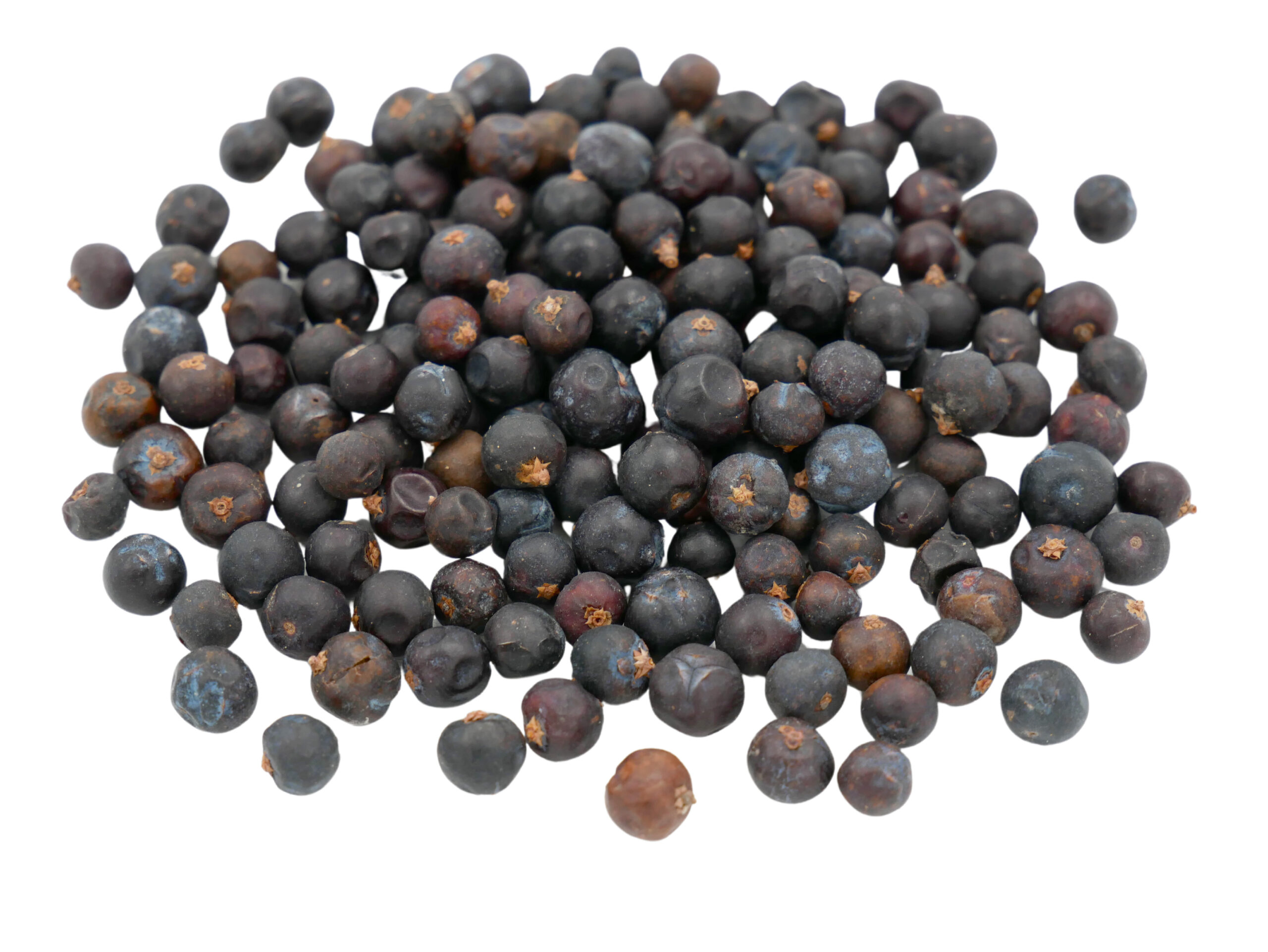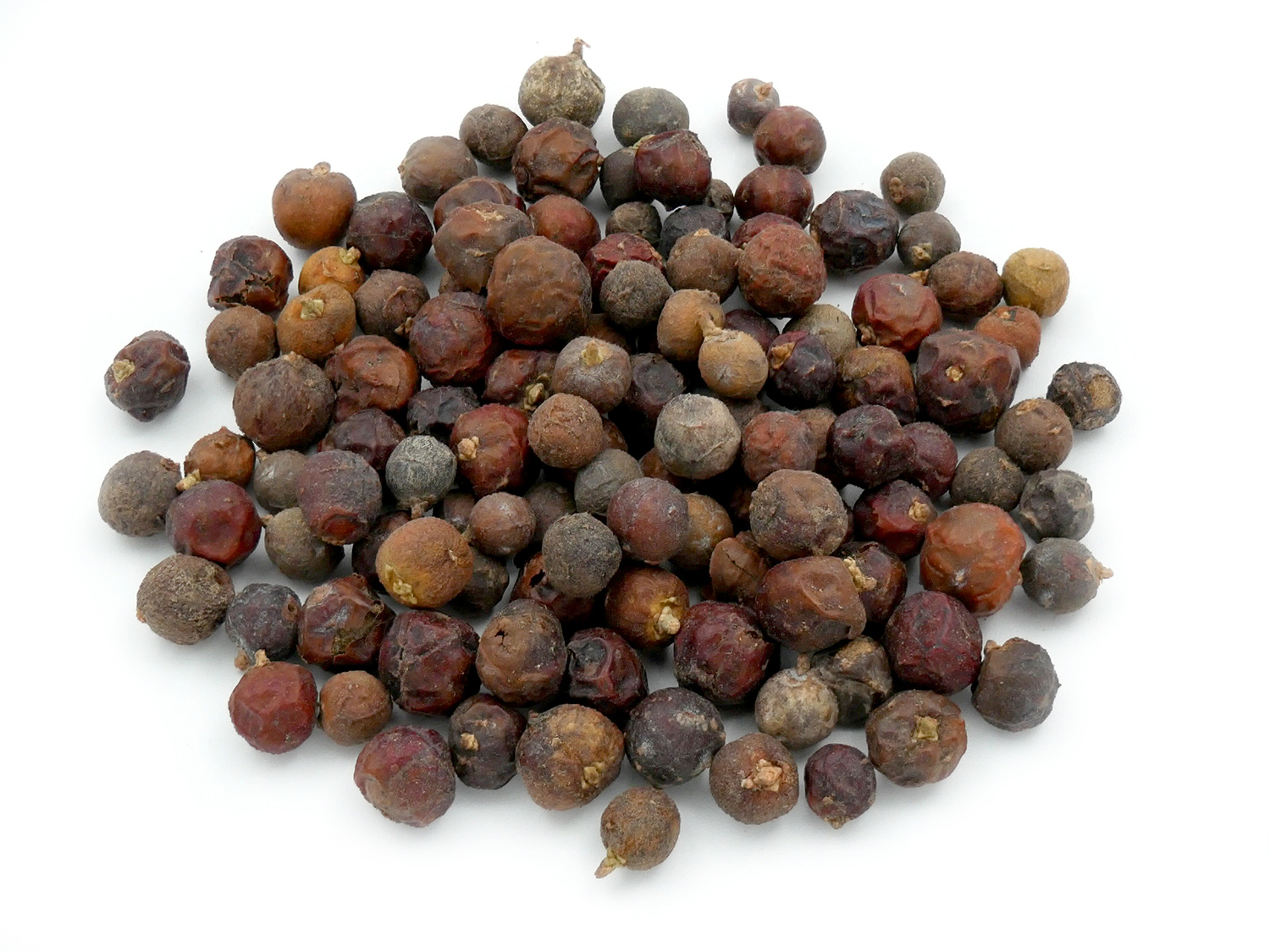Juniperus communis / J.recurva
ENCYCLOPEDIA BOTANICA / JUNIPER
Juniper is an instantly recognisable flavour, especially for those familiar with gin. But within that familiar profile you can find sharp, sweet, earthy, bitter, juicy, pine, mineral, petrol, manure, jammy, rose-floral and citrus notes—it's a wonderfully complex botanical, which makes it so interesting to work with.
Description & Habitat
Juniper is an ancient tree belonging to the Cupressaceae family. It’s a large extended family and the junipers are numerous—there are over 50 different species of juniper that grow throughout the world. Juniperus communis is the variety that's most commonly steam distilled for its essential oil and used in cooking and spirits—aperitifs, digestifs, liquors and of course gin. Himalayan or weeping juniper (Juniperus recurva) has also long been used in aromatic products like incense as well as in Ayurvedic medicine—and is also now increasingly being used as a gin botanical.
Believed to be a native of Syria, juniper is now found across the continents from North America to Scotland. The bushes can be low-growing—these hardy, prickly shrubs often growing in arid and rocky hillsides. The berries (which are actually small cones) are harvested when they are a deep blue (often after two-three years, as this is their ripening cycle). The bushes are beaten with sticks and the ripe berries are caught in sieves. It’s an old-world harvesting technique, no mechanical harvesting here.
Parts used: Berries for spirits and cooking, leaves and berries for steam distillation of essential oil.
Aroma & Flavour Profile
How to describe the taste and smell of juniper? Juniper is just so wonderfully complex: an initial burst of berry sweetness that’s just under the skin (used to entice the birds to eat and disperse the seeds). This is followed by dry-pine and a touch of citrus peel bitterness, as you bite into the seeds, it becomes astringent, resinous and hints or turpentine—dry and acrid. All to protect the seeds from fungal and bacterial attack while they are finding a place to germinate.
Like grapes, the climate and terroir factor hugely in juniper’s intensity and dominant flavours. Tasting your juniper will reveal much about it’s make-up, and we recommend you get to know what you are working with (see ‘How to taste a botanical’). Gin distillers commonly use J. communis from Eastern Europe, Italy and Morocco. At Alembics, we often use both Macedonian (J. communis) and Himalayan (J. recurva) juniper, take a look how they compare below:

Macedonian Juniper (J. communis)

Himalayan Juniper (J. recurva)
Macedonian v Himalayan
In appearance, Macedonian has a uniformity of colour, deep purple-black. The skins are smooth like fine leather, and each berry has the shape of a pentagram where it was attached to the stem. Recently harvested berries are fat and firm, and it takes a little pressure when placed between the fingers to flatten them. When the berries age the skins dry out, it becomes more brittle and there are indentations.
Himalayan juniper berries are overall quite a bit larger than the Macedonian with a greater diversity of colour. Rather than black they are a range of shades in the mocha-coffee-chocolate colour palette. The size of the berries is also not uniform, most are large but a small proportion can be half the size. The texture is drier, if the skin is described as leathery—it’s an aged leather—used to extremes. The pentagram is not so evident, it appears to be a quadrilateral shape.
Taste and aroma: When the Macedonian berry is held between the teeth, the skin soon starts to soften and a sweet nectar flows which soon turns to a cacophony of flavours and aroma—citrus, pine forests, sweet and herbaceous. As the saliva breaks the flesh down and the inner seed is exposed the mouth begins to dry out and a bitter taste develops, leaving a dry, spicy-peppery, terpenic finish. Himalayan berries feel firmer and more resilient in the mouth, taking longer to soften and release their flavour. The initial taste is neutral and rather than a burst of sweetness at the forefront, there is a burst of pine resin which melds into a sweet, intensely pine flavour, and a strong pine aroma. As the whole berry so ftens and starts to disintegrate there is again a cacophony of aroma and taste becoming bitter and dry. The finish is sweet and tepenic with strong green-conifer notes. Less peppery and spicy on the finish, but there is a salty-florality which is difficult to define.
As you can see, for those keen to experiment—with gin blending or perfume especially—there is a lot to explore in these different profiles.

Recommended techniques
•Hydro distillation • Steam distillation (EO) • Spirit distilling (gin, liqueurs) • Tincture •
Uses
Spirits
Simply put, it’s gin! Gin is never gin without juniper berries. It really is the hero gin botanical and no matter how far you stray from classic proportions, anything that calls itself gin has to have some juniper in it. Most gins use J. communis but increasingly J. recurva (Himalayan juniper) is being included in some modern blends. We find blends just using Himalayan juniper are very intense, so have been experimenting with these two varieties in The Lab to find our perfect ratio. It’s not just exclusive to gin, it can be used for vermouth styles and in botanical spirits where a piney dry note is needed. It has been infused in wines and distilled as aperitifs. Juniper is used to add a dry, piney bite to bitters blends.
Hydrosol
The hydrosol is intense with a soapy, floral aroma. It blends well with rosemary, lavender and bay hydrosols, either individually or in combination. It can be used as part of a Zero ABV spirit, and combined with the other classic gin botanicals. While hydrosol is very different to an alcohol extraction as the terpenes—which carry the pine, citrus notes—are not water soluble, it does still give a gin-like character. Juniper hydrosol can be used as a refreshing mouthwash as being an antiseptic and soothing hydrosol, it makes a great room freshener and linen spray. Enjoy it mixed with Epsom salts for a foot bath to soothe swollen sore feet.
Essential Oil
The essential oil is very much of the forest—dry, piney, uplifting and cleansing. It’s used in aromatherapy blends to stimulate circulation, relieve digestive discomfort, in addition to inhalers for respiratory conditions, and stimulate the lymphatics.
Perfumery
Juniper is used as a bridging note, or mid note in perfumery. It brings a sharp, crisp fresh note to natural perfume blends. It’s powerful, so best used in small doses. Penhaligon's Juniper Sling is a famous commercial perfume example.
Main compounds
Juniper berries contain a-pinene, myrcene, limonene, sabinene and terpinen-4-ol (among other molecules). We have a diagram of the main molecules behind juniper's flavour profile here. Take a look at the common notes it shares with many other classic gin botanicals—it will give you a good idea of how blending is used to layer and elevate particular flavour elements in a recipe.
GSMS reports
Here's a link to GCMS table (from Circle H Institute) where you can see the main chemical constituents of a classic juniper hydrosol. This analysis shows you which compounds are present after a hydro-distillation of J. communis. We also have two tables here, that compare the main components in the essential oils of J. communis and J. recurva. *It's important to note that different methods of extraction will yield different levels of compounds in their respective GCMS analyses. Some compounds are water-soluble, so will be present in higher levels in hydrosol, while some are not and will be present at higher levels in oils.
References & Resources
Associated courses and publications


